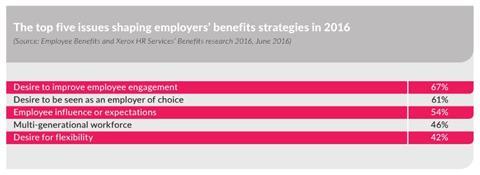
Need to know:
- The definition of personalisation has changed and is now data driven.
- The personalisation of benefits helps to empower employees to perform at their best at work.
- Challenges to the increasing use of personalised benefits packages include many employers' desire for standardised benefits systems, particularly in large, multi-national organisations.
The initial personalisation of employee benefits can be traced back to the 1980s, when the term referred to employers offering staff a wide choice of benefits to take up, typically on a flexible or voluntary basis, in the hope that they would appeal to at least some of their workforce.
But now personalisation refers to a precise, data-driven approach to benefit and reward strategy design that ensures that perks are relevant to individual employees who are, therefore, more likely to take up and value them.
Added value
As part of this evolution, employers are becoming more of a facilitator of benefits, whereby they offer staff access to a wide range of benefits that can be personalised, such as nutritional or DNA testing, and which can therefore add value to their workplace experience.
Alastair Woods, partner in the reward team at PricewaterhouseCoopers (PWC), says: “[The] personalisation [of benefits] is about employers providing some level of customisation to individual employees and not just groups among their workforce, but within an existing framework, rather than offering radical choice. Choice allows employees to extract value.”
Advances in technology have been instrumental in enabling employers to customise their benefits proposition. Employers are now able to access and mine data from their benefits portals relating to, for example, benefits take-up trends, which they can use to inform their benefits selection for staff. Mark Ramsook, a senior consultant at Willis Towers Watson, says: “Without technology, it’s unfeasible to consider how employers can manage benefits data, identify trends, and track and enable the purchasing process [of these benefits].”
Interactive benefits
Technological development is also benefitting employees in the form of increasingly interactive benefits portal interfaces. Employers’ previous static platforms that stored benefits information in the form of PDFs have been transformed into portals that allow employees to create and personalise their own user accounts from which they can select their preferred benefits. Increasingly, staff in many organisations can flex the value of these benefits up and down, and perhaps even extend access to perks to close family members.
“Choice allows employees to extract value because where there’s choice, there’s more understanding,” says Woods. “Employees are putting greater value on something that’s relevant for them.”
As well as strategy, many benefits can be personalised, such as company car schemes. Organisations can work with company car providers to enable staff to define everything from their budget to the type of seat covering and engine that they want for their car.
Similarly, health and wellbeing benefits, from health cash plans to dental healthcare, can be personalised by staff. Kirsten Samuel, managing director at health and wellbeing services provider Kamwell, says: “By having choice and flexibility at their fingertips in regards to health and wellbeing, employees can feel truly supported, empowered and energised to take control of their wellbeing.
“I have experienced so many instances first hand, where employees have told me about the difference their organisation’s health and wellbeing programme has made to their lives, not just as a means to ‘fixing’ a health problem. It offers an opportunity to enhance their wellbeing, enabling them to thrive in their personal and professional lives.”
Creating this sense of empowerment is key for employers keen to increase employee engagement and become an employer of choice. Nicky Moffat, director at What Good Leadership Looks Like, says: “Empowerment benefits organisations because it enables the collective and creative power of [employees] to be mobilised in line with a common vision or goal.
“[Employees] who are empowered have ownership of outcomes. They can use their expertise, initiative and skill to complete tasks and feel a much greater sense of satisfaction and value than if they had simply been told what to do.”
Personalised working practices also help to empower employees. Flexible working is a case in point. Martha How, reward partner at Aon Employee Benefits, says: “Empowerment is about staff management and about, for example, [employers] asking employees how they want to work and allowing employees to carve out their own working time.”
Standardised benefits approach
Perhaps the biggest obstacle to more employers taking this approach is the desire for standardisation for which many organisations, particularly larger multi-national entities, strive across their benefits policies and systems.
Peter Reilly, principal associate at the Institute for Employment Studies, says: “Frequently, [employers] want to signal that everyone is part of the same [organisation] with harmonised terms and conditions. Standardisation is also cheaper to operate [for employers]. Both tendencies militate against personalisation.”
Clearly, there is a long way to go before more organisations embrace the modern definition of personalisation, but change is afoot, particularly around reward, given the bearish economic climate and consequent lack of pay rises.
“We’ve got to a place where there’s a head of steam and pent-up frustration [among employees] with reward generally, [because] it hasn’t really changed, says PWC’s Woods. “It has always been about salary, a bonus if [employees] are lucky, a pension and some core benefits, but I think in the next few years we’ll start to see a greater array of choice.
“Now, more than ever, there is a greater need for the customisation of reward because of the diversity of the workforce coupled with the [downturn in the] economic cycle.”
This diversity, be it in the form of age, culture, religion or life choices generally, therefore needs more than a generational segmentation exercise across organisations’ communication strategies as employees demand more of a consumer experience from their employers.

Reed Business Information offers employees personalised health and wellbeing programmes
Reed Business Information (RBI) created a health and wellbeing programme in 2014 to help employees to create their own support systems that enable them to enjoy a positive workplace experience.
Lawrence Mitchell, marketing director and programme lead, says: “We set up the programme to enhance the energy and the performance of our staff, which in practical terms means that we’re energising and helping staff to feel good about themselves so they can not only feel better, but work better, which will enhance not only their own performance, but the performance of the business.
The business information and data services organisation’s Living Well Programme is based on a five-pillar framework. This includes eating well, moving the body and keeping fit, mental health and resilience, giving back, in line with the organisation’s charity agenda, and getting support, which is about staff tapping into employee networks and getting support from peers.
As part of the programme, which health and wellbeing services provider Kamwell helps to deliver, staff are offered access to wellbeing events, which may offer, for example, free gym classes, massage therapy, mindfulness training and nutritional advice and testing.
“It provides customised one-to-one services, as well as broader opportunities for staff to engage,” says Mitchell. “We think about employees as whole people and recognise that each employee will want different things based on who they are and where they are in their life journey, so we offer a range of benefits for them to engage in.”
Empowerment is at the heart of RBI’s programme, with employees encouraged to take responsibility for their own health and wellbeing. “As an [organisation] we are responsible for making it easier for employees to be healthier and for them to feel their best,” Mitchell says.
The organisation uses the programme to help improve employee engagement and staff retention and to improve the value of the employer brand.

Viewpoint: How can employers build empowerment into their reward policies?
Empowering staff is an understandable objective for organisations operating in today’s knowledge and service economy. Releasing employees’ discretionary effort can lead to higher productivity and better customer service, and one key way of getting greater employee engagement is through giving colleagues more autonomy. This means offering them access to more space to shape their work and to determine how best to meet customer needs.
Moreover, employers moving away from a command-and-control approach to staff management to delegated responsibility fits the changing workforce demographic where employees are less deferential and wanting to give more meaning to their jobs.
So how can employers build empowerment into their reward policies? The obvious way is through personalisation or mass customisation, where staff can shape their rewards much more to suit their own wishes and circumstances. In one way this is not new: flexible benefits have been the means by which organisations have for many years allowed individual tailoring of the benefits package.
However, flexible benefits have always had their limitations. One is that they ignore base or variable pay, where most of the money goes. Another constraint is whether sufficient cash is made available to offer real flexibility and, third, whether there is restriction in which benefits employees can choose.
So real mass customisation would involve employees having greater choice of benefits and scope to alter their pay mechanism.
The trouble is that organisations often use their reward and performance management systems to change the culture of their organisation, to incentivise certain behaviours in staff and to focus employee effort on key deliverables, with standardisation driving their approach. Real empowerment is about employers letting go and accepting that employees will sometimes make poor decisions, which they will learn from.
Commonality has its benefits, but it has to be set against the virtues of allowing staff to shape their working lives, including their reward, in ways that satisfy the business and simultaneously suits themselves.
Peter Reilly is principal associate at the Institute for Employment Studies












